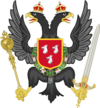Atmora
This article is incomplete because it is pending further input from participants, or it is a work-in-progress by one author. Please comment on this article's talk page to share your input, comments and questions. Note: To contribute to this article, you may need to seek help from the author(s) of this page. |
Atmoran Confederation Atmoraanse Statenbond | |
|---|---|
| Motto: Splendor sine occasu (Latin) | |
| Anthem: Merck toch hoe sterck (anthem) Alexandriëmars (march) | |
| Capital | Alexandria |
| Largest city | Pruzhana |
| Official languages | Dutch |
| Recognised regional languages | English • Mizuhese • Spanish • Vozhski • Voshanskya |
| Ethnic groups (2015) |
|
| Religion |
|
| Demonym(s) | Atmoran |
| Government | Federal parliamentary constitutional monarchy |
• Monarch | Katherine II |
| Lysithea van Hresvelg | |
| Legislature | Parliament |
| Senate | |
| House of Representatives | |
| Independence from the Hespirese Empire | |
• Atmoran Unification | 15 December, 1812 |
• Confederation | 6 January, 1813 |
• Constitution | 13 May 1813 |
| Area | |
• | 8,444,958 km2 (3,260,617 sq mi) (2nd) |
| Population | |
• 2015 estimate | 253,238,014 (2nd) |
• 2015 census | 253,238,014 |
• Density | 29.987/km2 (77.7/sq mi) |
| GDP (PPP) | 2015 estimate |
• Total | ƒ13.698 |
• Per capita | ƒ54,091.44 (2nd) |
| GDP (nominal) | 2015 estimate |
• Total | ƒ13.698 (2nd) |
• Per capita | ƒ54,091.44 |
| Gini (2015) | 18.68 low (1st) |
| HDI (2015) | very high (2nd) |
| Currency | Atmoran Guilder (Aƒ) (ATG) |
| Date format | dd/mm/yyyy (CE) |
| Driving side | right |
| Calling code | +1 |
| Internet TLD | .at, .gov, .mil and .edu |
Atmora (/'ətmôrə/), officially the Atmoran Confederation (Dutch: Atmoraanse Statenbond), is a federal parliamentary constitutional monarchy laying in the western Halkeginia bordered to the East by Vozh and to the Southeast by Ryurik Rossiya, across the Castarcian Sea in the west by Castarcia. It includes 18 constituent states, covers an area of 8,444,958 square kilometres, and has a largely temperate seasonal climate. With about 253.2 million inhabitants, Atmora is the most populous states in Halkeginia and the Halkeginian Sea. After Aravea, it is the third most popular immigration destination in the world. Atmora's capital and second largest metropolis is Alexandria, while it's largest city is Pruzhana.
Etymology
While manying have debated the orgins of Atmora, the name is widely believed to have come from the Caerenic people in Brunna region of Lieseltania which they named "Allt Mór", meaning "Great Valley". By the time of the Lieseltan conquest of Atmora in 57 BCE later used the word Atmore to describe not only the Brunna region but the entire Atmoran continent. By the 14th century Luxian explorers later called it by Atmora.
History
Geography
Flora and Fauna
Climate
Environmental Issues
Government and politics
Atmora is a federal parliamentary constitutional monarchy. Empress Henrietta II is the monarch and head of state of Atmora—being the foundation of the executive, legislative, and judicial branches of the Atmoran Government. The monarch's powers is limited and in practice, the use of the executive powers is directed by the Cabinet. The cabinet is responsible to the elected Parliament of Atmora and chosen and headed by the chancellor (at present Lysithea van Hresvelg), the head of government. The monarch may, though, in certain crisis situations exercise their power without ministerial advice. The monarch in practice normally appoints the leader of the party that can obtain the confidence of a plurality in the House of Representatives of Atmora.
The monarch appoints all ministers of the Crown, military officers, Governors and High Commissioners, public offices, and so forth. Usually however the monarch will appoint the nominees from her ministers.
The Government is comprised of three branches:
- Legislative: the bicameral Parliament of Atmora, made up of the Senate (upper house) and the House of Representatives (lower house) who are elected by the constituents of their states.
- Executive: the Privy Council and the Council of Ministers, are in which executive powers are exercised. With the Chancellor and Cabinet being appointed members of both the Privy Council and Council of Ministers by the monarch.
- Judiciary: the Supreme Court of Atmora, headed by the President of the Supreme Court of Atmora and lower federal courts, whose judges are appointed by the Monarch
In the Senate, there are 158 senators; 142 from all the states and 16 from the territories. The House of Representatives has 528 members elected from constituencies from the States and territories, allocated on the basis of population of the states and territories.
Administrative Regions
TBA
Constituent states
Kingdoms
| Flag | Name | Capital | Largest city | Area (km²) | Population | Minister-president |
|---|---|---|---|---|---|---|
| Kingdoms of Atmora | ||||||
| Lieseltania | Pruzhana | 4,251,708 | 84,995,250 | Lady Blennerhassett-Thynne | ||
| Gallia | Ghande | Brugge | 389,698 | 8,900,630 | ||
| Brunswijk | Lilianburg | Vianen | 1,973,166 | 50,552,554 | ||
| Larsenburg | Melverre | 1,442,847 | 22,575,158 | |||
| Asvarre | Castalien | Florennes | 1,307,875 | 48,034,235 | ||
| Huldenberg | Noorvik | Ottenburg | 1,930,923 | 26,545,245 | ||
Grand Duchies
| Flag | Name | Capital | Largest city | Area (km²) | Population | Minister-president |
|---|---|---|---|---|---|---|
| Grand Duchies of Atmora | ||||||
| Brandenburg | Astene | 157,195 | 1,078,005 | |||
| Guldenhof | Mariënburg | Castelré | 268,337 | 3,198,353 | ||
| Rothenburg | Rothenburg | 82,454 | 2,600,570 | |||
Duchies
| Flag | Name | Capital | Largest city | Area (km²) | Population | Minister-president |
|---|---|---|---|---|---|---|
| Duchies of Atmora | ||||||
| Alcanretia | Aldenburg | 68,760 | 256,821 | |||
| Menevia | Gwent | Nistelrode | 291,710 | 721,912 | ||
| Sayn-Ravenstein | Ravenstein | 167,884 | 526,183 | |||
Principalities
| Flag | Name | Capital | Largest city | Area (km²) | Population | Minister-president |
|---|---|---|---|---|---|---|
| Principalities of Atmora | ||||||
| Alsatia | Straatsburg | 22,929 | 868,198 | |||
| Doorn | Austerlitz | 78,467 | 725,789 | |||
| Leimuiden | Lichtenburg | 23,165 | 381,891 | |||
| Lippe | Bern | 96,950 | 1,277,220 | |||
Largest Cities
Largest Cities in Atmora
Atmoran Census Bureau | |||||||||
|---|---|---|---|---|---|---|---|---|---|
| Rank | State | Pop. | Rank | State | Pop. | ||||
 Pruzhana  Melvere |
1 | Pruzhana | Lieseltania | 7,479,225 | 11 | Meurs | Brunswijk | 1,194,734 |  Alexandria, Lieseltania  Florennes |
| 2 | Melvere | Larsenburg | 5,792,621 | 12 | Mentz | Larsenburg | 1,081,795 | ||
| 3 | Alexandria, Lieseltania | Lieseltania | 4,295,929 | 13 | Nisse | Lieseltania | 1,032,861 | ||
| 4 | Florennes | Asvarre | 3,979,576 | 14 | Noorvik | Huldenberg | 986,409 | ||
| 5 | Vianen | Brunswijk | 3,695,598 | 15 | Castelré | Guldenhof | 971,927 | ||
| 6 | Brugge | Gallia | 2,967,452 | 16 | Saint Annasburg | Lieseltania | 961,386 | ||
| 7 | Anthold | Lieseltania | 2,745,942 | 17 | Koningsberg | Lieseltania | 943,461 | ||
| 8 | Ottenburg | Huldenberg | 1,624,702 | 18 | Brühl | Lieseltania | 916,231 | ||
| 9 | Novigrad | Lieseltania | 1,467,452 | 19 | Meissen | Lieseltania | 871,621 | ||
| 10 | Moeskroen | Gallia | 1,259,627 | 20 | Castalien | Asvarre | 846,345 | ||
Foreign Relations
Military
The Atmoran Armed Forces, officially, the Her Majesty's Armed Forces which consists of three professional service branches administered by the Department of National Defence: the Atmoran Army the Royal Atmoran Navy, the Royal Atmoran Air Force. The commander-in-chief is the Atmoran Monarch, currently High Queen Katherine II, to whom members of the forces swear an oath of allegiance. The roles each branch is allowed to fill and the equipment they are allowed to operate is managed by the Department of National Defence (MND), and roles are regularly updated with changes in strategy, as well as tactical advancements.
TBA
Economy
Demographics
Education
Ethnicity
Ethnic groups of Atmora (Census 2080)
Historically Atmorans have identified with their regional identity than as apart of a greater Atmoran peoples. It wasn't until the age of enlightment that led towards the volksgemeenschapszin movement within the Atmoran states, along with the Atmoran Revolutions of 1750 were a greater Atmoran identity had begin to be formed. Additionally with almost 70% of Atmorans living within states ruled by the House of Wolf, a Wolfisch movement within Wolfsch states to further intergate helped further increase a call for an Atmoran state.
According to the 2015 Atmoran census by the National Institute for Statics: 76.3% identify as Atmoran (193.2 million), 7.8% as Voshany (19.7 million), 6.3% as Slavonic (15.9 million), 5.1% as First Nations (12.9 million), 2.9% as Mizuhese (7.3 million), and finally 1.6% identifying as others.
The largest ethnic group within Atmora are the Atmorans who make up about 193.2 million, largely an amalgamation of various Dutch speaking subethnic groups within Atmora. The second largest group within Atmora are the Voshany who are descendended from the intermingely of Noordatmoraanse with the local Slavonic and First Nations population in Northern Lieseltania, today the Voshany make up a population of 19.7 million, but is estimated that 93.7 million Atmorans are to be descended from Voshany or Slavonic ancestors.
The third largest ethnic group in Atmora are the Slavons who make up a population of 15.9 million. 67.9% of the Slavonic population is ethnically Vozhsky (10.8 million). 17.1% as Angaran Cossack (2.7 million), 7.3% as ethnically Wends (1.2 million), 5.8% as ethnically Diebalsky (925.3k), and 1.9% as other minor Slavonic groups (303.1k).
The fourth largest ethnic group in Atmora the First Nations who make up a population of 12.9 million are the one of the oldest indigenous peoples of Halkeginia. The first nations are generally spilt into three seperate groups First nations, Mesties, and the Inuit/Joepiks tribes. There are 9.3 million First nations people with Atmora, of various different tribal groups within Atmora making up 72.3% of the FN population. The Mesties make up 27.5% of the First nations population, and are a descendants of Atmoran/Slavonic men with First Nation women in the Karth-Siletzian region, in total they make up a population of 355.2k. The smallest first nations group within Atmora reside along the Sidnese Sea the Inuit and Joepiks who make up 1.2% of the FN population or roughly 154.9k people.
Religion
Religions in Atmora (2015)
Languages
TBD




